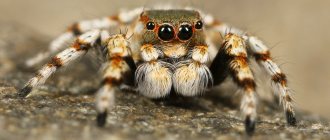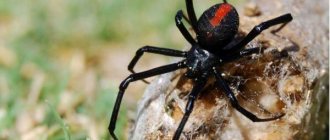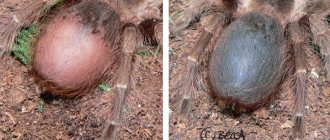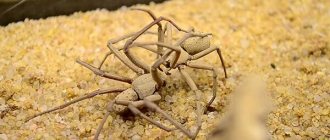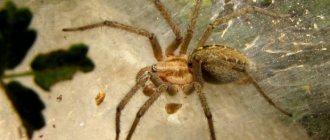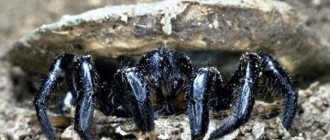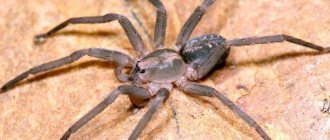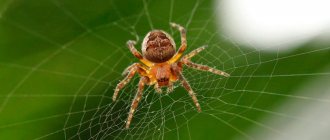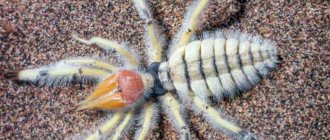Natural enemies of jumping spiders
Photo: Jumping spider in nature
Spiders have quite a lot of enemies in their natural habitat. It is in order to save lives that many spiders disguise themselves externally as other insects - ants or beetles.
The danger to spiders comes from birds that eat these small arthropods. The spidercatcher bird shows particular interest in them. It is also worth noting that it is these spiders that lizards or frogs, as well as insects that are larger in size, are happy to hunt. Spiders tend to eat each other if there are no other objects nearby that can become prey. We are talking not only about the female, who after mating can eat the male. Often adult, sexually mature spiders attack young animals.
Very often, jumping spiders become victims of wasps. These are parasitic insects that lay eggs on the surface or inside the body of spiders. After some time, larvae hatch from the eggs and slowly eat the arthropod from the inside. If there are too many larvae, they provoke the death of the spider.
Causes of black spiders in the house
The appearance of these arthropods can be explained by the following reasons:
- location of the house. It is considered normal for domestic arachnids to live in private homes. Especially when the house is closer to a planting, forest, or park. Although in megacities there is enough flora where representatives of this species are found, which crawl from the street into the house;
- residents can carry them into the house themselves. Or, with the help of the wind, spiders “fly” through open windows and doors;
- black spiders, like all living things on earth, are looking for housing where all favorable conditions for life are created. Spiders are no exception. Especially if there is a lot of food in the house - bedbugs, flies, ticks, cockroaches, and mosquitoes.
Reproduction
Tegenaria domestica leads a solitary lifestyle and gathers in pairs only during the mating period. The male looks for the female’s web, carefully approaches, and pulls the threads. The female, at the sight of the “suitor,” either rushes to attack or sits motionless in the center of the funnel. The second option means that the lady is ready to accept the gentleman. After mating, the couple remains together for some time. Then the most important thing for the male is to leave in a timely manner, otherwise he will simply be devoured.
After a few days, the female begins to weave a cocoon from the web, lays eggs there, and hangs it from the funnel, where she herself lives. The cubs develop in about 20 days, during which time the tegenaria protects them. About 50 spiders are born. They stay together for about 2 weeks, their mother feeds them, then they scatter in different directions.
What do funnel web spiders eat?
Grass spiders weave a horizontal dense web that converges downward in the form of a funnel. The network is supported by vertical support threads. The web of these predators is not sticky, but loose: small insects caught in it get stuck in it and cannot get out. The horizontal upper network turns into a hidden lower one, which in turn transforms into the spider’s refuge - a tube enveloping the burrow. In it, the spider waits for a signal from the catching net, after which it abruptly runs head first (which is typical for stray spiders) and bites the victim. He takes the caught prey into his tube and eats it there, or rather sucks it out.
Photo credit: Apdency, Public Domain
Spiders catch and bite only moving animals. If the victim caught in the web freezes and does not move, the funnel web spider will provoke it by tugging at the web, wait patiently, but will not touch it. Some agelenids may lack a cloth, but all have a living tube (burrow). The webs quickly become clogged with dust, and therefore the spider does not stay in one place for long. After 2-3 weeks, he changes his place of residence and weaves new networks. Funnel web spiders are mainly active at night; only representatives of the genus Malthonica hunt both day and night.
Funnel web spiders feed on a variety of arthropods, sometimes even dangerous to them. In addition to softly chitinized flies, mosquitoes, leafhoppers and small spiders, they catch honey bees, orthoptera, beetles and ants. When a prey gets caught in a web, the owner instantly runs out, moving along the web, and inserts chelicerae into the body of the prey. At the ends of the chelicerae on the claw, glands open, which inject poison and enzymes into the body: they turn the insides of the victim into liquid porridge. Grass spiders do not put the victim in their mouth for better digestion, they simply suck out the already dissolved entrails, waiting for the enzymes to finish their work.
Photo credit: Andy Murray, CC BY-SA 2.0
How it weaves a web and what it eats
The web has a triangular shape and is most often located in dark corners, or behind a cabinet or cabinet. It is flat and horizontal, the center is usually located in the corner, forming the so-called living tube where the predator lives. This web is devoid of glue; It has a loose structure, due to which insects become entangled in it, which serve as food for its builder.
After the prey is confused, the predator approaches it and waits for its first movement, since it is not interested in stationary objects. Immediately after this, he bites into her with his jaws, releasing poison that kills the victim. In addition, this poison digests the body inside a dense shell so that the predator can suck out the liquid contents due to the absence of a large mouth and the inability to absorb solid food. He can catch about 10 different insects a day, but he won’t be able to eat them all at once, so he wraps them in a web and takes them closer to their immediate habitat.
Did you know? In New Guinea there is a spider that weaves a very thick web - they use it to catch fish in this area!
Where does the water spider live?
Photo: Water spider in Russia
It prefers a temperate climate, and lives in the territories of Europe and Asia located in it - from the Atlantic Ocean to the Pacific. It prefers to live in stagnant water; it is also acceptable for it to flow, but slowly, which means its main habitats are rivers, lakes and ponds. He especially loves abandoned, quiet places, preferably with clean water.
It is also desirable that the reservoir be abundantly overgrown with vegetation - the more there is, the higher the chance that silverfish live in it, and if they do, then most often there are many of them at once, although each one makes its own separate nest. Externally, the spider's home can either resemble a thimble or a small bell - it is woven from cobwebs and attached to stones at the bottom.
It is very difficult to notice because it is almost transparent. In addition, it does not allow air to pass through. The spider spends most of its time in its underwater nest, especially for females - it is reliable and safe, because signal threads stretch from it in all directions and, if there is a living creature nearby, the spider will immediately know about it.
Sometimes he builds several nests of different shapes. Silverfish can be kept as pets. This is quite rare, but it happens, because they can be interesting with their nests and silver glow. One spider can be kept in a small container, but several will require a full-fledged aquarium.
They do not conflict with each other, but if they are underfed, they can enter into a fight, after which the winner will eat the loser. They adapt well in captivity, but they need to arrange an environment of aquatic plants, and so that some of them appear on the surface (or throw branches) - this is necessary so that the spiders get out for air.
Although they are poisonous, they are not inclined to attack people; this is only possible if the spider defends itself - such situations can occur when a silverfish is caught with a fish, and it thinks that it is being attacked. Usually it tries to escape from people, and spiders that are accustomed to living in captivity react calmly to their presence.
Now you know where the water spider lives. Let's see what he eats.
Ways to prevent
Spiders will not live where there are no suitable conditions.
Therefore, everything possible should be done to make insects uncomfortable within the walls of human housing. Methods for preventing the appearance of “furry guests” in an apartment and a private house are slightly different.
In urban housing, the following measures must be taken:
Vacation home
In a private home, it is more difficult to prevent the appearance of “uninvited guests”. It is necessary to monitor the rooms, utility rooms, and adjacent areas.
If the house has an attic, basement, or storage room, they should be cleaned regularly
Pay attention to corners, crevices, and shelves. , dirty boxes. Spiders love to spin webs among branches.
Therefore, do not plant bushes and trees under your windows.
Spiders love to weave webs among branches. Therefore, do not plant bushes and trees under windows.
The area should be regularly cleared of fallen leaves, rotten fruits, and branches.
Firewood cannot be laid along the foundation of a house. Surely the spiders will want to settle there.
Don’t forget about watering your beds, trees, and lawns. Arachnids will not want to live where water appears regularly.
Features of character and lifestyle
Photo: Funnel-web water spider
The silverfish goes out hunting at night and rests most of the day. Females rarely leave the nest except to replenish their air supply - perhaps for hunting. But even she is often led passively, barely leaning out of the nest, and waiting until some prey is nearby.
Males are much more active and can move away from the nest at a distance of up to ten meters in search of food. Although most often they also remain within a meter or two, under the protection of their networks, ready to react to signals emanating from them at any moment.
They can overwinter either in cocoons, which they weave themselves, or in empty mollusk shells. They prepare their silverfish for winter in a very interesting way: they draw air inside until they float, then attach them to the duckweed and crawl inside the shell.
When the shell is ready, you can go into hibernation - it will be warm enough inside for the water spider to survive even in the most severe cold. Such floating shells can be seen in the autumn months - this is a sure sign that silverfish live in the reservoir, since without their help the shells rarely float to the surface.
When winter comes, the duckweed falls off, and the shell goes to the bottom along with it, but thanks to the dense web, the water does not flood it, so the spider successfully overwinters. In the spring, the plant floats up, and with it the shell; sensing the warmth, the silverfish wakes up and climbs out.
If the summer is dry and the reservoir is dry, then water spiders simply spin cocoons and hide in them from the heat, waiting until they find themselves in the water again. Or they can fly away on a web to other lands, in search of a larger body of water that has never dried up. In any case, they are not in danger of death in such situations.
Varieties
Sydney (Australian)
This species is one of the most dangerous and poisonous (after the Brazilian soldier spider and the six-eyed sand spider), as the Sydney funnel-web spider attacks its prey quickly and furiously. With its long and strong fangs, it can easily bite not only skin, but also nails, especially children's. It bites mercilessly and lightning fast, sometimes even several times. The venom of this spider is so strong that one bite is enough to kill a child.
If the victim is not promptly helped by administering an antidote, he dies within 15 minutes.
In terms of dimensions, this spider is quite large. The length of the female, including limbs, can reach 7 cm. Males are more miniature with thin, long limbs. The males are the most poisonous of this species. The color of the spider is dark, turning to black. There is almost no hair on their surface, so they look smooth and shiny. The homes of Australian spiders are deep, branched burrows in tree trunks or in soft soil with several entrances. On the inside, the walls and the entrance of the hole are shrouded in cobwebs.
Brown
Females of this species of spiders are very caring mothers who look after their spiderlings for a month after birth. No one dares to disturb their peace, otherwise the female mercilessly kills the troublemaker, whom she subsequently eats. The spider also feeds its children with the killed victim. This type of spider has its own communication system. For example, when cubs want to eat, they touch their mother with their limbs. Thus, the female understands that it is time to feed them.
Brownie
This is the yellow funnel-web spider that is most familiar to us, as it can be found in any home, closet, barn and other rooms. Sometimes you can see a dark brown pattern on the back of house spiders. The female is usually much larger than the male.
They place trap webs in the corners. In appearance it looks straight, but its central part drops sharply into the depths of the corner. These spiders are most active at night. The house spider is not dangerous to humans, since its bites are not poisonous.
Labyrinthine
This spider usually lives in meadows and fields. It stretches its web directly on the grass, securing it to the stems. The color of the labyrinth spider is yellow. The average size of an adult individual reaches 2 cm. The spider's abdomen is dark, with sparse fur on it forming an abstract pattern. There are 2 dark stripes running along the entire length of the labyrinth spider’s back.
Characteristic
In our homes, the most common species is tegenaria domestica, or house spider.
- Body dimensions are about 12 mm. Moreover, the female will always be larger than the male, the size of the latter often does not exceed 9 mm.
- Their abdomen has an oblong shape and is usually colored yellowish or beige-brown. The color of males is always darker.
- The powerful limbs are decorated with dark rings, while in males the area at their base is almost black. The first pair of legs is the longest, often longer than the back.
- As you can see in the photo, the main distinguishing feature of the house spider’s appearance is the pattern on its back, made up of brown spots. Moreover, in young animals it is absent and appears on the body only after three molts.
- House spiders have four pairs of eyes: two pairs are in the same row in the front of the cephalothorax, two lateral eyes and another pair on top. The latter are basic, all the rest are simple.
The closest “relatives” of our house spider are representatives of the species Tegenaria agrestis, or the American house spider. Another species of the funnel-web family is known to science - this is Tegenaria duellica, or the giant house spider. These creatures are notable for the fact that they wage a fierce fight for prey, during which they can kill their own kind.
Habitats
In nature, funnel web spiders, which include tegenaria domestica, can be found under the bark of trees, in the forest floor and under fallen leaves. Often they also choose places near fallen trunks, old snags, small hollows or grass thickets, in which it is very convenient for these spiders to place funnel-shaped trapping nets.
For the house spider, premises are the most preferable - that is why it was named that way. Tegenaria domestica lives in basements and cellars, in various technical rooms and, of course, in residential buildings and apartments. It hangs its web, as a rule, in dark corners or in more secluded places, for example, behind cabinets, and then patiently waits for prey to appear. The fishing net is almost flat, has a triangular shape and is located in a horizontal plane, and its central part (the living tube) will always go sharply into the corner - where its owner sits.
Hunting
The house spider hunts mainly in the dark, and it can do this both with the help of a web and without it. The whole point here is that his trapping net does not have adhesive properties; it simply does not have those sticky knots to which the prey sticks, and therefore it is not of particular value as a trap itself. Tegenaria's web is a thick, dense carpet in which prey usually “drowns.”
In the first case, hunting occurs as follows. An insect that accidentally finds itself on the surface of the web begins to shake it, which creates vibrations. The hunter instantly catches them by the vibrations of the signal thread, immediately jumps out of his ambush and, with sliding movements, approaches his food. It attacks prey, plunges its sharp fang-like jaws into its body and injects poison and digestive juices through special channels. Soon the insect dies, after which the tegenaria drags it deep into the living tube. And after the internal contents are partially digested, the spider begins to eat - it sucks out the liquid contents, leaving only the chitinous shell intact.
On a note! But sometimes a very brave victim can be caught in the tegenaria network, such as ants. Despite its small size, the fast, agile and brave little ant is able to give a worthy rebuff to the hunting spider. Armed with powerful jaws, it repels the enemy's attacks, which quickly exhausts him. Thus, the tired spider goes into its tube, and the winning ant bites off the threads of the web from its legs and also leaves!
Usually the house spider does not stay long in one web and as soon as the first one is filled with the remains of captured insects, it begins to make a new one. The frequency of change of residence is two to three weeks. One day of hunting brings about 10-12 insects, but since he is not able to eat all of them at once, he has to put aside the excess in reserve. The diet of tegenaria domestica includes mainly small fruit flies, large house flies and some household pests.
On a note! The house spider cleans residential buildings and apartments of many parasitic insects, which does us a huge favor!
And the second way of hunting is without thick snares. In this case, the spider uses only two signal threads, which it extends in a certain area. In the future, catching prey occurs according to the scheme described above: the potential victim catches the thread, the tegenaria reacts, catches up with it and bites.
Reproduction
When the time comes for romantic courtship, males begin to look for a passion for mating. When finding himself near the female’s web, the newly made suitor must be extremely careful, as there is a fairly high risk of being attacked or even killed. He can spend several hours in agonizing anticipation.
First, the male usually steps on the edge of the web and is located on its lower side, and as soon as the female appears from the funnel, he crawls to the top of the web. If the owner does not immediately attack, but remains to wait, then the suitor very slowly approaches her, literally millimeter by millimeter. At the same time, he is always on the alert and at any second, at the slightest hint of aggression on the part of his beloved, he is ready to run away. Having come close enough, the male, without breathing and with a sinking heart, very carefully touches the female’s front leg.
Some time after mating, the female lays a clutch. She lays the eggs in several flat cocoons and hangs them on her web. The hatched young spend some time near their mother. The settlement of young tegenaria occurs after about a year, when they already know how to hunt on their own.
Description
Tegenaria is a family of funnel-web spiders that construct housing in the shape of a funnel pipe, to which they attach a triangular web with an area of up to 3 square meters. dm.
The female is always larger than the male, sometimes one and a half, or even 2 times
. A standard male rarely grows more than 9-10 mm, taking into account the paw span, while their female friends reach 15-20 mm.
The predominant color of the body is brown (slightly lighter or darker), complemented by leopard print patterns. Sometimes the pattern on the abdomen looks more like a herringbone. Males are darker than females, and the darkest, almost black shade occurs at the bases of powerful limbs.
Males are slimmer than females, but both are equipped with long legs, where the first/last pair is much longer than the second/third, which allows the spider to move quickly.
An ignorant person can easily confuse a house spider with a very similar stray (biting) spider, which poses a certain danger: its bite provokes the appearance of a slowly healing ulcer.
Tegenaria is not capable of biting through skin, and its poison is not so strong as to seriously harm the human body.
How to appease a brownie in an apartment or house
Like any other living creature, a neighbor can be offended. Sometimes the reasons for his dissatisfaction are obvious, but sometimes it is very difficult to guess what you did wrong.
Why do brownies get offended:
- You don't care about order - you rarely clean the apartment or do it anyhow.
- Leave sharp or cutting objects on the table. This spoils the good energy that Dedko so diligently creates.
- In the house and apartment you can constantly hear curses, reproaches and quarrels. Again, this is negative energy that the neighbor is struggling with.
- Family members forget to treat the brownie. For him, human food comes as a treat, and not the main food, but do not forget about small signs of attention.
The more negative energy accumulates in the house, the more upset the good spirit becomes. After all, his task is to maintain an atmosphere of well-being in the apartment.
How to appease a brownie:
- Conduct energy cleansing of the apartment. For example, washing floors with salt or walking around rooms with a candle. And it’s nice for you to breathe, and it’s less work for him!
- Leave some goodies for your little friend from time to time. Don't know what he eats? Everything is very simple. Brownies, like children, love sweets: cookies, candies, honey or jam, sugar, milk.
- Dedko is still a neat guy. He is happy when there is no dust or dirt in the house. Walk around the apartment with a damp cloth, sweep and wash the floors, and his mood will immediately improve.
- Do not forget to thank the spirit for its help when it warns of danger. Brownies are not required to do this. They only care so much about people when they are very attached to them. It's always nice to know that your help is appreciated.
Interesting fact. Surely you have never thought that brownies also celebrate birthdays! You won't have to guess when your protector was born. A long time ago, people already chose a day that became a holiday for the brownie. The Domovits' birthday falls on February 10th.
Why do spiders prefer to live in houses and apartments?
The most suitable conditions for these arthropods are damp, dark, cool places with a lot of insects. The ideal place that matches the description is a cellar or basement. But if there are a lot of spiders in the apartment, then there are reasons for this:
- Dampness. Problems with plumbing or sewerage, leaking faucets and pipes - all this will create favorable conditions for spiders. They live under the bathroom, behind the toilet and pipes;
- Unsanitary conditions. During cleaning, all hanging cobwebs are brushed away from the corners with a broom or sucked up with a vacuum cleaner. When such procedures are carried out regularly, they do not have time to weave a new web for themselves;
- Insects. All animals need to eat. If there are a lot of small pests at home, this will certainly attract unwanted residents.
There are fewer dangers for spiders in houses and apartments than on the street. Therefore, if spiders appear in the house, it means that favorable conditions have been created for them.
Features of behavior
The name "hermit" is explained by the solitary lifestyle. The animal is active at night, preferring solitary hunting. The hermit's web does not have an orderly pattern, it is extremely sticky to the touch, and is made of chaotically located white threads.
In wild nature
The hermit spider lives in warm climates, but is able to survive frosts down to 35 degrees, hiding under a stone or log. Arthropods live in forest areas and open spaces, preferring dry and secluded places.
In a private house
The domestic recluse spider can be found in secluded corners - in the attic, in the basement, under the bathroom, in crevices and inaccessible places. House spiders also live in utility rooms - garages, sheds, barns.
Arthropods often penetrate bedding, nest in closet compartments, inside beds and nightstands.
How does a spider weave a web?
The thread of the web consists of many thin threads, which the spider glues together with a special liquid that quickly hardens in air. Thanks to this, the strength of the web is achieved so high that spiders even travel with its help, covering kilometers of distance.
The web can be dry, sticky, elastic - it all depends on the purpose of the thread.
Types of threads for webs:
- for cocoon
- catching sticky thread
- for moving
- to entangle prey
- thread for fastening
Stages of weaving a web:
- The spider releases a long thread first. Such a thread is picked up by the air flow, rushes to the nearest branch and clings to it (Fig. 1, 2).
- Then another free-hanging thread parallel to the previous one is woven. The spider moves to the middle of this thread, which is stretched under its weight, and weaves another thread in a downward direction until it finds a third support (Fig. 3).
- The spider attaches a thread to the support and forms a Y-shaped frame.
- Next comes the general contour and several more radii (Fig. 4).
- An auxiliary spiral is woven at these radii (Fig. 5). This entire frame is woven from non-sticky thread.
- Next, the spider weaves a second spiral with a sticky thread, towards the middle of the web from its edge.
Construction may take 1-2 hours.
Tarantula spiders mating
Phrynes - types, photos and names
Modern classification divides the order of flagellated spiders into 5 families, which include 21 genera and 136 species. Most varieties were discovered in the 19th century. Among the most studied types of phrynes are the following:
Phrynus longipes
this is a fairly large representative of flagellated spiders: the body length of the phryne reaches 5-6 cm, and the leg span can be more than 20-25 cm. Like all phrynes, the body of individuals of this species is flat, the limbs are very long and rather thin. A pair of longer legs performs a tactile function; the pedipalps are claw-like and covered with frequent sharp spines. Phryne is gray in color, which allows it to almost completely blend in with the colors of the walls in damp and dark caves, where the spider prefers to spend almost its entire life. Habitat: Puerto Rico. Representatives of the species practice cannibalism, eating their relatives with appetite.
Phryn Phrynus marginemaculatus
lives in southern Florida, the Bahamas, Cuba and Haiti. Adult individuals have a body reaching 1.8 cm in length, the forelimbs are 10 cm long. Individuals prefer to live in small groups, which usually include 3-5 females with offspring of various ages. Even grown-up cubs do not separate from their mother, they tenderly care for their relatives, but all members of the group are quite aggressive towards strangers and protect their habitat from uninvited guests.
Phryn Damon medius
The body size of the flagellated spider is 3-4 cm, the limb span reaches 25 cm. Phrynes of this species have a flat body and rather thin legs. Males have very long forelimbs and much longer pedipalps than females. Feeds on small insects. Phryn Damon medius lives in Benin and Guinea, is found in the forests of Liberia, Cameroon, Ghana and Mali, less often its representatives can be seen in Nigeria and Senegal, in the Democratic Republic of Sao Tome and Principe, the Republic of Cote d'Ivoire, in the Sierra Leone.
Phryn Charon grayi
distributed in Malaysia and the Philippines, lives in the Solomon Islands and Indonesia, and is often found in Singapore, Palau and Papua New Guinea. Like other flagellated spiders, it prefers a nocturnal lifestyle, being active in the darkness of damp caves.
Phryn Damon diadema
The body size of the spider varies from 4 mm to 3 centimeters, the leg span reaches 20 cm. The color of the phryne is predominantly dark gray; against the general background there are transverse stripes of a light brown tone. The abdomen is noticeably lighter than the cephalothorax. This flagellated spider lives in Central Africa, Kenya, Tanzania, Ethiopia, Yemen, and Somalia.
Phryne (Damon variegatus)
one of the largest frins. The body size of the arachnid is 4.5-5 centimeters, the limb span is 25-28 cm. The body shape of the phryne is flat, like that of other flagellated spiders. Phryne lives in dark, damp caves and shady forests of East Africa, mainly in Tanzania.
Types of house spiders
Spiders are predators by nature. They live all over the world except Antarctica. Insects feed on other arthropods or smaller animals.
Of all the species of spiders (more than 42 thousand) only a few are able to survive in a human home.
It is difficult to notice the presence of arthropods, since they prefer to settle in secluded corners of the apartment: behind furniture, under window sills, on the ceiling. You can recognize the type of insect by its distinctive external features and the features of its web.
Haymaker
The haymaker is also called a window spider or centipede. The body size of the animal does not exceed 1 cm. House spiders differ from other types of arthropods by the presence of long legs.
The color of the insect varies from red to brown. The belly of the harvestman is slightly darker than the back. The individual weaves its web chaotically and often settles in attics, in the corners of rooms, and on windows.
Interesting information! The harvest spider often appears in houses in the autumn, when the air temperature drops significantly.
During the day, the insect can be seen on the wall with its legs spread out to the sides - this is how the animal basks in the sun. The individual attacks people only if there is a threat to his life. The bite of a harvestman is not dangerous to humans, since this type of insect is not poisonous.
Female centipedes lay eggs in the fall or summer. They weave cocoons for eggs from their own web. Larvae emerge from eggs after 2-3 weeks. The larvae resemble the adult harvestman, but are lighter in color.
The pigtail lives up to 12 months.
To get rid of the presence of arthropods in the house, it is enough to carry out a wet general cleaning of the room.
Black house spider
The insect's usual habitat is trees. An animal can get to a person with a flow of wind through open doors and vents. Animals enter the living space by moving along the walls.
Female black house spiders are larger than males: they grow up to 3 cm (including splayed legs).
In rooms, insects hide in corners, behind furniture. In appearance, the web resembles complex, random patterns. Animals feed on other small insects: moths, cockroaches, beetles, butterflies.
Black spiders cannot actively reproduce outside their own free will. Their activity fades with the onset of winter. Wet cleaning will help you get rid of the problem in your apartment.
Hobo Spider
The house spider reveals its presence only by its web. He does not appear in bright areas of the apartment, but prefers dark corners.
Interesting fact! Vagrant spiders living in Russia do not pose any threat to human life. The Brazilian relatives of the species in question are considered very poisonous. A child dies within 15 minutes from a bite from an adult if the antidote is not administered in a timely manner.
Arthropods enter from the street accidentally: through open windows and doors. Hobo spiders have a brown body color and powerful long legs. There are dark stripes on the insect's legs.
Females of the species are always larger and more agile than males. The average lifespan of hobo spiders is 2 years, but in captivity they live much less.
Females are able to reproduce only in nature (once a year). In the apartment, the reproduction of arthropods stops.
Jumper
In total, there are 6 thousand species of jumping spiders. They got their name from their ability to jump. Unlike their relatives, individuals have good eyesight and catch prey not only with the help of a web.
The color of the insect has a varied range. The house spider has a flattened abdomen, a raised cephalothorax and massive legs. Animals live in trees and bushes. It gets into the house by chance, just like other spiders.
Jumpers are the few species of arthropods that do not spin webs. They hunt during the day.
Female racehorses lay eggs in large numbers. To do this, they weave a special cocoon. The adult guards its nest until the larvae are born.
Important! The jumper does not pose a threat to people. Because its venom is not poisonous: it only affects small insects (flies, midges, beetles).
White house spider
One of the most dangerous spiders living in Russia is white. House spiders live in the south of the country and are otherwise called karakurts. The insect is able to enter people's homes in the summer.
A karakurt bite causes negative reactions in humans: allergic rashes on the skin, puffiness and swelling of the damaged area of the epidermis.
Children may have breathing problems and muscle spasms.
Video
Tarantula spiders for beginners. WHICH SPIDER TO GET FIRST????
Harm and benefit
The harm of funnel-web spiders is negligible compared to their benefits. Of course, especially poisonous spiders cause enormous harm to humans, but such species are very rare. The main harm we have to face is just the annoying web.
The benefits of spiders are global. After all, spiders are very voracious creatures. Every day they need food weighing at least their own body weight.
Some spiders are able to use their nets to catch more than 100 insects per day, among which flies predominate.
Now imagine that in open areas (fields, meadows, forests) on 1 hectare of land there live from 1 to 5 million all kinds of spiders, and each spider eats at least 2 flies a day, then how many of these pests die thanks to spiders! After all, flies are actually not such harmless creatures as they seem at first glance. The fly is a carrier of a huge number of harmful microbes - about 26 million of all kinds of microbes live on the body of one individual, causing terrible diseases in humans. And if it were not for spiders, then the entire planet would long ago have been filled with myriads of flies.
The internal structure of the body of spiders
Spiders are distinguished by the fact that they do not have a full-fledged circulatory system, as well as no blood, which is replaced by lymph. There is a heart, but a peculiar one, consisting of 3 or 4 holes, called awns. Through these openings, lymph enters the heart area, after which it is distributed throughout the body into the spaces between the internal organs. After this, the lymph enters the pericardial region of the body and is sent back to the heart. With the help of lymph, the spider receives the necessary portion of oxygen.
The spider's respiratory organ also has a unique structure. The respiratory system consists of plate-shaped pulmonary sacs that resemble books. The breathing holes are protected by special covers that open at the right time. The respiratory system also includes trachea tubes, which supply oxygen to the internal organs.
Spiders, despite the fact that they are predators, have a well-developed central nervous system consisting of nerve cells. Nerve formations are located in the cephalothorax, and from them nerve endings are distributed, directed to all organs of the animal. These nodes, the number of which is 2, are the brain of the animal.

